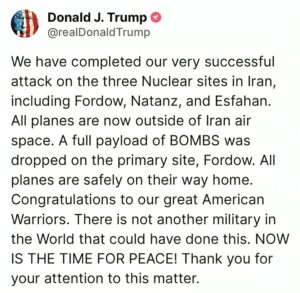US Strikes on Iranian 3 Major Cities Live Updates
US Strikes on Iranian 3 Major Cities Live Updates. Tensions between the United States and Iran reached a boiling point on June 21, 2025, when the US military launched targeted airstrikes against key Iranian nuclear facilities. The operation, announced by President Donald Trump, focused on three major sites: Fordow, Natanz, and Isfahan. According to Trump’s televised statement, these strikes were executed with precision and resulted in the “total obliteration” of the targeted nuclear infrastructure.

The backdrop to these attacks is a period of heightened hostilities in the Middle East, particularly following a series of aerial clashes between Israel and Iran. Israel, citing concerns over Iran’s nuclear ambitions, had already been conducting its own military operations in the region. The United States stepped in, aligning itself with Israel’s objectives and seeking to send a clear message to Tehran regarding its nuclear activities.
Iran’s authorities swiftly condemned the strikes, describing them as a blatant breach of international law. The Atomic Energy Organization of Iran confirmed the attacks and reported significant explosions near the affected sites. Iranian officials noted that the facilities had been evacuated prior to the strikes, which may have limited casualties but did not prevent substantial material damage. Despite the setback, Iran’s leadership vowed to continue its nuclear program, insisting it remains for peaceful purposes.

Is There a War Between the U.S. and Iran?
Despite the dramatic escalation, there is currently no formal declaration of war between the United States and Iran. The recent airstrikes, however, represent the most direct and forceful US military action on Iranian soil since the 1979 Iranian Revolution. While the operation was described as a one-time measure, it has pushed both nations to the edge of open conflict.
The possibility of a broader war remains a serious concern. Iran is now under intense pressure to respond, both from within its borders and from its regional allies. The US, meanwhile, has issued stern warnings, making it clear that any Iranian retaliation could result in even more severe military action. President Trump stated unequivocally that the US has “many more targets” should Iran choose to escalate.
International reactions have been mixed. Some world leaders have expressed support for the US and Israel, arguing that firm action is necessary to curb Iran’s nuclear ambitions. Others, however, have voiced alarm at the risk of a wider conflict, urging all parties to exercise restraint and seek diplomatic solutions.
Potential for Escalation
The situation in the Middle East is now extremely volatile. With both sides on high alert, the potential for rapid escalation is significant. Iran’s leadership faces a difficult choice: retaliate and risk a larger war, or hold back and risk appearing weak to its domestic and regional audiences. The US, for its part, has communicated through diplomatic channels that the strikes were not intended as a prelude to regime change, but rather as a warning against further nuclear development.
Despite these assurances, the region remains on edge. Any miscalculation or provocation could quickly spiral into a broader conflict involving not only the US and Iran, but also Israel and other regional powers. The world is watching closely as events unfold, with many hoping that cooler heads will prevail and that a diplomatic path forward can be found.
Diplomatic Efforts
In the wake of the strikes, there have been behind-the-scenes efforts to prevent further escalation. US officials have reportedly reached out to their Iranian counterparts, emphasizing that the operation was limited in scope and not intended to topple the Iranian government. The hope is that these messages will be received and that both sides can avoid a cycle of retaliation that would be devastating for the region and the world.
Meanwhile, global markets have already reacted to the news, with oil prices spiking and investors expressing concern about the stability of the Middle East. The economic impact of further conflict could be severe, adding another layer of urgency to calls for restraint and dialogue.
What’s Next?
The immediate future remains uncertain. Iran is expected to carefully weigh its response, balancing the need to demonstrate strength with the risks of provoking a full-scale war. The US has made it clear that it is prepared to take further action if necessary, but has also signaled a willingness to avoid further escalation if Iran refrains from retaliating.
In summary, while the United States and Iran are not officially at war as of June 22, 2025, the recent US airstrikes on Iranian nuclear sites have brought the two nations closer to open conflict than at any point in recent history. The coming days will be critical in determining whether the situation stabilizes or deteriorates further, with the entire world hoping for a peaceful resolution.

